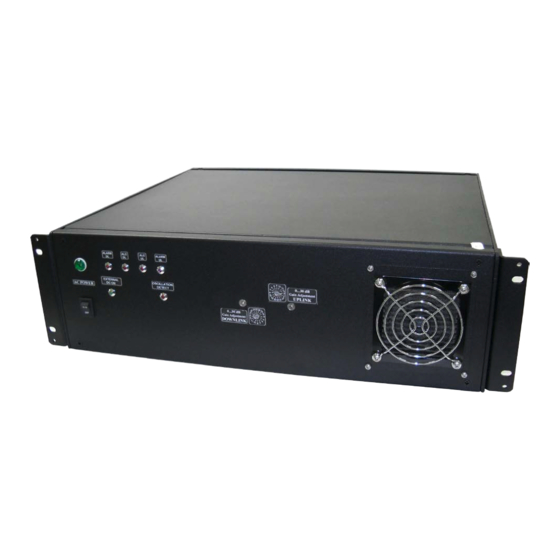
Summary of Contents for G-Wave BDA-PS7W-37/37-90-R
- Page 1 Installation Operating Manual BDA-PS7W-37/37-90-R PS700 Band Bi-Directional Amplifier...
-
Page 2: Table Of Contents
Table of Contents SAFETY OPERATION INSTRUCTIONS ................. 3 OVERVIEW ..........................4 FCC NOTE ..........................4 IC NOTE ............................4 NOTE ............................4 RF EXPOSURE WARNING-FCC ....................4 RF EXPOSURE WARNING- INDUSTRY CANADA .............. 4 ELECTRICAL SPECIFICATIONS .................... 6 MECHANICAL SPECIFICATIONS ..................6 ENVIRONMENTAL CONDITIONS .................. -
Page 3: Safety Operation Instructions
SAFETY OPERATION INSTRUCTIONS BEFORE USE Review this manual and insure that all conditions are compatible with the amplifier's specifications. Safe operation may be impaired if this equipment is not used as intended. GENERAL DESCRIPTION This symbol is marked in the manual and denotes important safety operation instructions. -
Page 4: Overview
BDA-PS7W-37/37-90-R provides up to 37 dBm composite power and has up to 85 db gain. FCC NOTE This is a Class B device. The product has been tested and found to comply with the Booster requirements per FCC Part 90. - Page 5 Refer to Figure 1 for the BLOCK DIAGRAM DESCRIPTION following discussion. The downlink path of BDA receives RF signals from the base station, amplifies the signal and transmits the signal, without changing the frequency, into a Distributed Antenna System at the direction of the mobiles.
-
Page 6: Electrical Specifications
ELECTRICAL SPECIFICATIONS 758 - 775 MHz (In USA) Down-Link Frequency Range 768 - 776 MHz (In Canada) 788 - 805 MHz (In USA) Up-Link Frequency Range 798 - 806 MHz (In Canada) Pass band Gain @ Min. attenuation Up to 85 dB Variable Step Attenuator Range 2-dB 0-30 dB steps... - Page 7 Optional Battery Back-Up Configuration 15 Amp Fuse 12 Volt 12 Volt Lead-Acid Lead-Acid 15 Amp Battery Battery Battery of Figure 2: Optional Battery Back-Up Configuration Typical DC Recommend Current Battery Battery Rated Output Composite Draw Back-Up Time Capacity Power @24VDC [Hours] (20 Hour Rate) [Amp Hours]...
-
Page 8: Mechanical Outline
MECHANICAL OUTLINE Figure 3: Mechanical Outline P a g e... -
Page 9: Connections
CONNECTIONS The RF connections are made via two “N-type” female connectors. The RF connector labeled “BASE” must be connected to the antenna pointing towards the base station. The RF connection labeled “MOBILE” must be connected to the antenna / passive DAS facing the area to be covered by the BDA. -
Page 10: Available, Optional Features
) • Visual Alarms All G-Wave systems include local visual alarms as a standard. Local visual alarms are LED lights located on the unit that indicate various failures. For a list of corresponding alarms, please see Variable Gain Adjustment and LED Indicators. -
Page 11: Alarm Conditions
AVAILBLE, OPTIONAL FEATURES (Cont.) • DC28 Powered DC Only @ + 28 VDC • LGHT Lightning Protection on UL/DL Ports • Red Enclosure to signify equipment is for public safety. Please verify your local requirements. • ACSP AC Surge Protection and DC Line Conditioning (Required if powered by generator) ALARM CONDITIONS The alarm monitors the current of both the uplink and downlink amplifiers. -
Page 12: Variable Gain Adjustment And Led Indicators
VARIABLE GAIN ADJUSTMENT AND LED INDICATORS • AC Power LED - Illuminates when the AC voltage is supplied, the unit is ON, and the AC/DC power supply is operating. • DL ALC LED - Illuminates when DL composite power reaches the ALC set •... -
Page 13: Installation
INSTALLATION DO NOT APPLY A.C. POWER TO THE UNIT UNTIL CABLES ARE CONNECTED TO BOTH PORTS OF THE BDA AND THE ANTENNAS. Place the BDA in the cabinet. Using appropriate screws and anchors or attach the BDA to the wall at the four mounting holes on the side flanges (special version not shown in this manual). -
Page 14: Operation
Verify the downlink in-building signal strength and the uplink signal strength at donor antenna meets requirements. Reduce the gain if needed. Note: Operation of BDA-PS7W-37/37-90-R at maximum gain with greater than -30 dBm average power incidents on the MOBILE or BASE ports could cause damage to the BDA. -
Page 15: Diagnostics Guide
DIAGNOSTICS GUIDE The BDA provides long term, care-free operation and requires no periodic maintenance. There are no user-serviceable components inside the BDA. This section covers possible problems that may be related to the installation or operating environment. Gain Reduction Possible causes: Defective RF cables and RF connections to antennas, damaged antenna or Leaky cable Occasional Drop-out of some Channels Possible causes: One channel with very strong power dominates the RF output of the... - Page 16 APPENDIX 1 26-Pin Connector Conditions for Donor Alarm (26-pin) This functionality applies only for a Donor antenna with a DC short. Alarm monitors the connection of the BDA to the donor antenna. An alarm condition will occur if there is a disconnect at the donor antenna. Uplink and Downlink amplifiers will shut down.
- Page 17 Alarm Block Diagram 17 | P a g e...
- Page 18 APPENDIX 2 The horizontal I and vertical I space antenna isolation for a scenario as in Figure 6 can be dh ∙ f [ db ] = 22 + 20log � computed analytically, using the following equations: � − GTx − GRx 3 ∙...











Need help?
Do you have a question about the BDA-PS7W-37/37-90-R and is the answer not in the manual?
Questions and answers